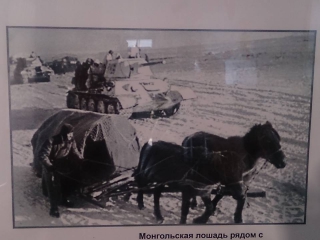ID :
366446
Thu, 05/07/2015 - 13:50
Auther :
Shortlink :
https://oananews.org/index.php//node/366446
The shortlink copeid
"MONGOLIAN HORSES REACHED BERLIN, TOGETHER WITH SOVIET TANKS"

Ulaanbaatar /MONTSAME/ One of many donations that the people of Mongolia had dedicated to the victory of the war on Nazism was a half million horses for the Soviet Red Army. This Army owned 526.4 thousand horses by the beginning of the Great patriotic war, this number amounted to one million 234 thousand by January of 1941.
Then-Mongolian People’s Republic (MPR) started supplying horses to the Red Army in 1941. The Government of the MPR launched a planned works to “prepare” horses for the USSR, as a result of which a total of 485 thousand horses were delivered to the Soviet Union within the four years of war. The Red Army, regardless of the size of wartime budget, did not have any other reliable supplier of horses than the MPR. Only North America had owned that many horses, however, obviously had been too high in terms of price. Meanwhile, the Mongolian horses served as non-fueled self-feeding technologies that sometimes became food for the Army. According to the narrations by the veterans, the half-wild Mongolian horses were exceptionally tolerant in the burdensome conditions of the Eastern front. "Mongolian horses, with their small but rigorous bodies and enduring strength, had reached Berlin, shoulder-to-shoulder with the Soviet tanks," highlighted General Issa Pliyev, who had led the mechanized horse-divisions in 1941-1945.
Mongolian herdsmen also donated 32 thousand of their best horses as moral support for the USSR. The Mongolians had not been limited by supplying the horses. Under a slogan "Everything for the front, everything for the victory" Mongolia had donated meat, wool and cashmere. While the USA supplied 665 thousand tonnes of reserved meat on a lend-lease term, Mongolia donated 500 thousand tonnes of fresh meat. Eight hundred thousand Mongolians at that time suffered from hunger due to the transporting of livestock by millions to the Soviet. In winter of 1944, the MPR prochlaimed and transferred to “10-hours a working day” regime.
The MPR also supplied wool for producing warm coats and boots. The Mongoliain people had delivered aid of clothes, containing sheep hide deels (national clothing), marmot hats, wool gloves and felt boots. By November 7 of 1941, several divisions that had been preparing for countercharge around Moscow were fully dressed with Mongolian-made clothes. In 1943-1945, one out of five horses in service for the Red Army was Mongolian, and one out of five warm boots were produced with Mongolian sheep wool.
The USSR imported from Mongolia many rare earth metals including wolfram, which had been used for production of armor-piercing (AP) shells to be utilized against “Panther” and “Tiger” tanks of Nazi-German Army.
As seen from the above evidences, the everlasting significance of the Mongolian people’ contribution to the Glorious Victory in the Great patriotic war should be remembered solemnly.





